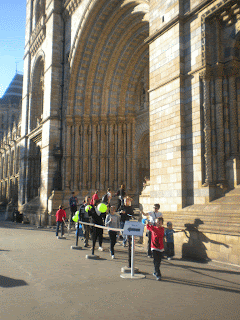Natural History Museum
Wednesday, 3 November 2010
Sunday, 3 October 2010
Architectural History of the Natural History Museum
This is the ground floor plan of the Natural History Museum.
It is clear that this plan and construction is symmetrical due to the similar structures of both sides of the building
.
History of the Museum
The Natural History Museum in London is one of three major museums located on Exhibition Road in South Kensington (others are the Science Museum and the Victoria and Albert Museum and the main entrance of the MHN is from the Cromwell Road).
The construction of the building began in 1873 and completed in 1880 with a Roman-Byzantine style of architecture.
The official opening took place in 1881 and according to tradition, the museum has free admission.
The museum houses some 40 million zoological and botanical objects, including bones of dinosaurs, various fossils (such as Archeopteryx) and a 30-meter-long skeleton of a blue whale and a mode (etc).
The museum houses some 40 million zoological and botanical objects, including bones of dinosaurs, various fossils (such as Archeopteryx) and a 30-meter-long skeleton of a blue whale and a mode (etc).
The chosen site in South Kensington was previously occupied by the 1862 International Exhibition building, once described as ‘the ugliest building in London’. Ironically, it was the architect of that building, Captain Francis Fowke, who won the design competition for the new Natural History Museum.
However, in 1865 Fowke died suddenly and the contract was awarded instead to a rising young architect from Liverpool, Alfred Waterhouse.
Waterhouse altered Fowke’s design from Renaissance to German Romanesque, creating the beautiful Waterhouse Building we know today. By 1883 the mineralology and natural history collections were in their new home. But the collections were not finally declared a museum in their own right until 1963.
.
Monday, 27 September 2010
Natural History Museum - Walking Experience
South Kensington station is the closest tube station to the Natural History museum.
I therefore decided to start my walk from the station to the museum.
When I got out from the station I walked to the right.
As you can see there is a clear turn just around the corner to the right where I will continue to walk.
This bus stop has a crowd of people surrounding it.
Further down you can see a crowd of more people who are waiting at the same stop.
From here you can begin to see the Natural History museum from a distant of approximately 50-75 meters.
This is the beautiful entrance of the Natural History Museum.
This is a picture of the external design of the building.
When I say external design I talk about the patters on the building which you can see is quite continuous.

Here I am walking away from the museum. As you can see there is a long straight road which is named Cromwell Road.
Subscribe to:
Comments (Atom)































































